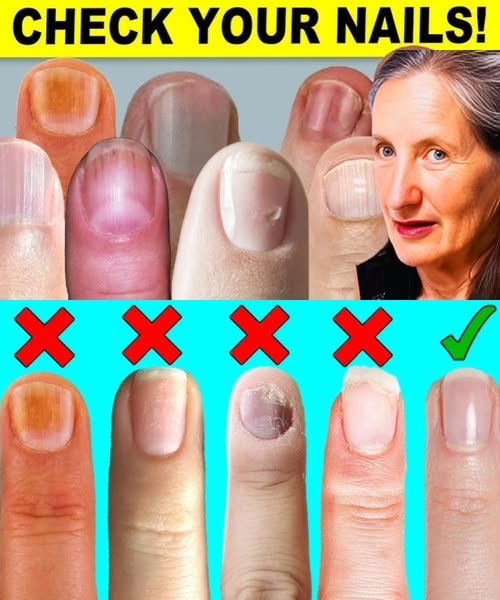9 Things Your Nails Can Tell You About Your Health 💅✨
Your nails do much more than make your hands look good. They are strong indicators of your overall health, often reflecting underlying conditions before other symptoms arise. Changes in the appearance, texture, or color of your nails could signal something important that should not be ignored. Here are 9 things your nails might be telling you about your health:
1. Pale or White Nails – Anemia or Liver Issues
If your nails appear unusually pale or white, it could signal anemia, a condition caused by a low red blood cell count. This could also point to liver diseases, such as hepatitis or cirrhosis. The lack of color may indicate poor oxygenation in the blood or insufficient nutrients.
When to see a doctor: If the white or pale nails persist, especially along with other symptoms like fatigue, dizziness, or weakness.
2. Yellow Nails – Fungal Infection or Lung Problems
Yellowing nails are often a sign of a fungal infection. However, in some cases, they could indicate respiratory issues, like chronic bronchitis or even thyroid disease. Persistent yellow nails should be investigated to rule out infection or more serious health issues.
When to see a doctor: If the yellow color is accompanied by thickening, crumbling, or pain in the nails.
3. Brittle, Cracked Nails – Thyroid Problems or Nutrient Deficiency
If your nails are brittle, cracked, or split easily, it might be due to hypothyroidism, a condition that slows down metabolism and affects nail health. A deficiency in biotin, iron, or essential fatty acids could also be to blame.
When to see a doctor: If the brittleness is combined with symptoms like weight gain, dry skin, or fatigue, it might be time to check thyroid function.
4. Dark Lines or Streaks – Possible Melanoma
Black or dark brown streaks on your nails should never be ignored. These could indicate melanoma, a form of skin cancer. It’s essential to seek immediate medical attention if you notice such streaks, especially if they are uneven, change over time, or are associated with other skin changes.
When to see a doctor: If you spot dark streaks, especially if they’re new or irregular, schedule an appointment with a dermatologist.
5. Bluish Nails – Low Oxygen Levels
Nails with a bluish tint suggest that your body isn’t getting enough oxygen. This could be a sign of lung diseases such as COPD or heart conditions that affect blood circulation. It’s critical to investigate the cause of low oxygen levels.
When to see a doctor: If your nails are turning blue along with shortness of breath, chest pain, or fatigue, consult a healthcare provider.
6. Spoon-Shaped Nails – Iron Deficiency or Heart Disease
Spoon-shaped nails, or nails that curve upwards at the edges, may indicate iron deficiency anemia or possible heart disease. This condition is called koilonychia. It’s also linked to liver disease.
When to see a doctor: If you notice this change along with fatigue, weakness, or palpitations, get your iron levels checked.
7. Pitting or Dents – Psoriasis or Autoimmune Disorders
Small dents or pits in the nails can be a sign of psoriasis, an autoimmune skin condition. Nail pitting can also occur with other autoimmune diseases like alopecia areata or lupus.
When to see a doctor: If you have other symptoms like skin rashes, hair loss, or joint pain, it might be time to see a specialist for autoimmune diseases.
8. White Spots – Minor Trauma or Zinc Deficiency
White spots on your nails are often the result of minor trauma, such as accidental bumps. However, frequent or persistent white spots could suggest a zinc deficiency.
When to see a doctor: If the white spots are frequent and don’t seem to improve, consider consulting your doctor to rule out nutrient deficiencies.
9. Ridges on Nails – Aging or Nutritional Deficiencies
Vertical ridges are common as people age, but if you notice deep horizontal ridges (also known as Beau’s lines), they could indicate serious health conditions like diabetes, high fever, or malnutrition.
When to see a doctor: If you have deep ridges or horizontal lines, especially if they develop suddenly, it’s worth seeing a doctor for a health assessment.
When to See a Doctor
While some nail changes are harmless and result from minor injuries, others can point to serious underlying conditions. If you notice persistent discoloration, unusual growth patterns, or sudden changes in your nails, it’s always best to consult a doctor for further evaluation. Early intervention can lead to better outcomes, so it’s important to listen to what your nails are telling you.
Q&A Section:
Q1: Are changes in nails always a sign of a serious problem?
A1: Not always. While many changes in nails can indicate health issues, sometimes they are simply due to minor injuries or temporary nutritional deficiencies. However, if changes are persistent or associated with other symptoms, it’s important to see a doctor.
Q2: How can I prevent nail health issues?
A2: Good nail care involves keeping your nails clean, moisturized, and trimmed. Eating a balanced diet rich in vitamins and minerals, staying hydrated, and avoiding harsh chemicals will also help maintain healthy nails.
Q3: Can nail changes be reversed with treatment?
A3: In many cases, nail changes can be reversed with appropriate treatment, such as correcting a nutritional deficiency or managing an underlying condition like anemia or thyroid issues. However, the timeline for improvement depends on the severity and type of the condition.
Q4: Should I worry about occasional white spots on my nails?
A4: Occasional white spots are usually harmless and often result from minor trauma. However, if the white spots persist or appear frequently, it could signal a zinc deficiency, and you should consult a healthcare provider.
Q5: Can nail changes occur from stress or emotional issues?
A5: Yes, stress can affect overall health, and in some cases, it can impact nail health. Stress may lead to conditions like nail biting, pitting, or brittleness. Managing stress through relaxation techniques can help improve nail health.
Final Thoughts: Your nails are a window into your health. By paying attention to changes and understanding what they might indicate, you can take early action and prevent or manage health conditions. If you notice persistent changes, always consult with a doctor to ensure your health is in check. 🩺💅

